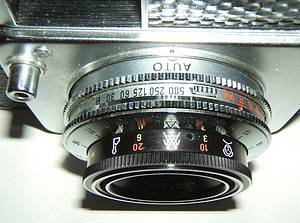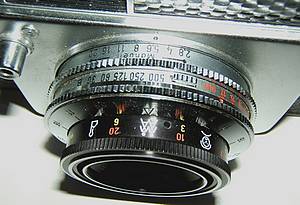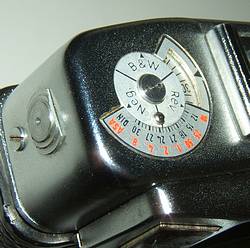|
The Ilford Sportsmaster Manumatic
offers shutter priority automatic operation or full manual control,
the latter aided by readings from the built-in selenium cell
exposure meter, with readings visible in the top of the viewfinder.
The ProntorMatic shutter offers speeds of 1/30, 1/60, 1/125,
1250, 1/500 & B. It is X flash synchronised. There is no
delayed action. The lens is a 4-element Ysarex, f2.8, 45mm, with
stops to f22. Focussing is from 3feet to infinity. There are
also three click-stop zone focussing positions for close-up,
middle distance and distant shots.
Once the camera has been loaded
with film, the film speed is set using the control ring around
the lens mount (see pictures below) and a suitable shutter speed
(to suit the type of subject or the available light) is selected.
Then, on looking through the viewfinder, you can see the field-of-view
covered by the lens and, when the shutter release is depressed,
the built-in photo-electric cell light meter automatically sets
the lens aperture according to the user's pre-chosen shutter
speed and the prevailing light conditions.
For manual operation, the rear
lens control ring is rotated to the manual position and then
both lens aperture and shutter speed can be selected. In this
mode of operation, a small button on the back of the camera can
be depressed and, on looking through the viewfinder, the lens
aperture is shown that would have been selected by the camera
if it was in automatic.
The manual setting is also
used for flash photography. A flash gun is connected to the standard
3mm co-axial (PC) outlet and the lens aperture is calculated
based upon the flash guide number (divide the flash to subject
distance into the guide number to determine the lens aperture).
Since the shutter has only X synchronisation, the shutter needs
to be set to 1/30th second when using flash bulbs, but can be
used at any speed with an electronic flash.
The left hand badge reads "ILFORD
MADE IN WESTERN GERMANY" while the right hand badge
reads "SM", which presumably stands for Sportsmaster
Manumatic.
|
|
The picture above is the Sportsmaster
Manumatic as it appeared when first launched. Note the extended
rewind crank, as appeared on other models only later in their
development.
An Ilford advertisement at
the time extolled its virtues:
"This beautiful camera takes the guesswork out of photography!
It really does the thinking for you, and you can switch to manual
control for special shots whenever you like. Undoubtedly the
Manumatic represents the very peak of precision-built camera
making. Coated four element f/2.8 Rodenstock Ysarex lens, Prontormatic
shutter speeded from 1/30 sec. to 1/500 sec plus 'B'. Bright-line
viewfinder. Rewind crank. Synchronised for electronic flash and
flashbulbs. £44 7s. 1d. = £44.35. Case an extra £3
8s. 7d.= £3.43."
Amateur Photographer (AP) dated
30th May 1962 described the new Manumatic:
"This model can be used as a fully automatic or manual camera.
Integral meter will select correct shutter speed and aperture
for perfect exposures every time. Automatic mechanism can be
uncoupled and the camera used as a conventional 5-speed model."
|
 |
 |
The Focal Guide describes the
automatic system thus:
"When the camera is set
to 'Auto', the meter mechanism sets the correct aperture automatically
according to the pre-selected shutter speed. The action of the
meter is controlled by the film speed setting. This model also
permits manual over-ride e.g. individual setting of aperture
and shutter speed. This does not, however, prevent the meter
from being used."
|
|
Notice that the focusing scale,
marked both in feet and metres (3feet to inf.) has three 'click
stop' preset focusing positions for distant views, groups and
individuals. There is no built-in rangefinder.
The red scale visible in the
pictures (above) on the shutter speed ring is for film speed
setting, 10 to 800ASA on one side and 11 to 30DIN on the other.
Depressing the serrated lever to the right of the 1/500th sec
shutter speed, allows the film speed to be set.
|
 |
The exposure counter is on
the top of the camera, at the RHS as viewed looking down from
above and with the lens facing forward. It is manually preset
to the number of exposures on the film by moving 'to and fro'
the adjacent button on the side of the top cap. Thereafter, exposures
are counted down automatically as the lever wind is used.
The exposure counter is integrated
with a manually set film speed & type reminder, for b&w,
colour negative or colour reversal. Film speeds are shown in
red for ASA and black for DIN.
The red numbers are shortened
for convenience of fitting them into the available space, hence
instead of 100, 200, 400 & 800ASA, the scale shows 1.., 2..,
4.. & 8.. ASA.
|